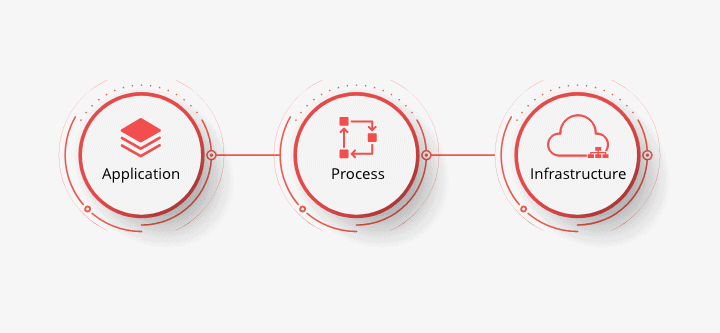
COBOL modernization
With most companies across the world moving towards digital transformation, the programming language COBOL has come back into focus, primarily because most older mainframe systems are COBOL-based. More recently, during the COVID-19 pandemic, COBOL has received some bad press due to aging systems not being able to handle the sudden increase in traffic. However, COBOL is not to blame, as experts point out. Most backend systems are robust but were not designed in anticipation of the possibility of such an unprecedented increase in traffic levels.
While the current crisis has highlighted the risks associated with COBOL-based systems, they continue to be the best solution for mainframe environments where bulk transaction volumes need to be handled simultaneously. In fact, COBOL has been a mainstay of government, business, and banking operations for nearly 60 years without any major challenge. Traditional industries, including Banking, finance, and insurance, rely on them for the speed with which they can process a large volume of transactions. Approximately 71% of Fortune 500 companies still use mainframes for certain applications.
Thus, it’s evident that mainframes won’t be replaced any time soon. However, to move towards successful digital transformation, companies need to undertake mainframe modernization by leveraging new technologies and software tools.
Why mainframe modernization should be a priority, and how to make it happen
While the resilience of mainframe environments make them ideal for business needs, they have high response times that work against them. Moreover, they cannot remain static since businesses continuously grow and evolve, due to which requirements change, and critical applications need to be modernized to keep pace with new demands. Modernization is crucial to business continuity, and there are several ways to go about it.
1. Multi-platform DevOps on the mainframe
Among the most viable approaches to the mainframe, modernization is to create a collaborative environment for delivery and development by using agile along with DevOps development to ensure rapid application delivery like with the new generation systems. It’s one of the reasons why around two-thirds of mainframe users are adopting multi-platform DevOps.
2. Preparing the next-gen team with modern technology
At the end of the day, the technology works according to human instructions. Therefore, it is essential to help the next generation IT workers to develop technical skills for working across a diverse range of systems, including the mainframe. Businesses need to take concrete measures to facilitate this.
3. Modernizing existing core systems
One of the key issues of modernization is to ensure that connectivity isn’t compromised. Therefore, when building a connected ecosystem, businesses need to employ the right IT infrastructure that integrates seamlessly across every part of the organization. Investing in additional mainframe and cloud capacity offers the flexibility for the business to operate in either a hybrid or virtualized environment, thereby ensuring connectivity always.
4. Updating mainframe applications alongside composite application architectures
Instead of starting from scratch for modernizing the mainframe, a quicker and more affordable alternative is to connect the existing mainframe applications with cloud and mobile apps. Java, JSON, and XML can be employed to connect with Enterprise COBOL to add a business functionality such as a new user experience. The data exchange format facilitated by JSON allows applications to access data and host-based processing from the mainframe.
Modernization with the lowest cost and risk across 3 key pillars
While connectivity is the primary concern to ensure that business-critical applications continue to function during the process of modernization, cost, and risk are other significant factors to consider. It merits a systematic evaluation of the three main pillars of technology:
1. Application
Low-risk methods to extend the functionality of an application include adding secure mobile and web experience, process automation, web services, APIs, and managed code models that facilitate composite application delivery.
2. Process
The goal should be to improve enterprise application delivery speed so that it can meet the current pace of change. Processes can be speeded up through agile development, continuous testing, DevOps-ready rapid application understanding, controlled user access, and accelerated delivery.
3. Infrastructure
Deployment of application across multiple platforms, including server, host, mobile, and cloud, as well as providing insulation for mission-critical IT systems against changes in the infrastructure, while simultaneously ensuring governance, access security and data protection controls can lower the risk of modernization.
Leverage COBOL modernization to get to higher digital ground
For successful digital transformation, IT leaders in organizations need to leverage new technologies as well as software tools to ensure that old mainframe systems get updated and keep pace with the latest requirements.
Implementing COBOL App Modernization to Unlock business value across a hybrid IT infrastructure
1. Faster deployment of mainframe apps
When working on the modernization of mainframe environments, IT teams need to consider efficient applications that can work across distributed, cloud, or virtual environments and can work along with DevOps or agile development.
2. Supporting flexible deployment across various types of IT infrastructure
The modernization efforts should support the organization’s digital transformation initiatives by creating a flexible environment that enables implementation across different types of IT infrastructure.
3. Ensuring shorter COBOL app delivery cycles and lower costs
Using Visual COBOL can offer programmers a superior development experience as it allows the application development team to collaborate better and deliver new functionalities faster.
4. Providing real-time, relational access to distributed COBOL data files
Specialty tools and development skills are required for working with COBOL data files. Otherwise, the modernization process could witness delays due to unforeseen downtime and recovery issues, thus affecting business continuity.
5. Strengthening access security and data protection for the core application
The process of updating aging enterprise systems poses the challenge of bringing them up to the expected security standards without posing a threat to business operations. Including features such as integration of host, identity and access management, centralized control, strengthening access and authentication as well as encrypting data to protect it while it is in motion can help to improve security.
6. Integration of mainframe and UNIX systems with Cloud apps
While updating enterprise systems is a mammoth challenge, legacy applications make the process even more difficult. The solution lies in using apps to integrate with the cloud to help to maintain business momentum.
Role of TechAhead in COBOL application modernization
TechAhead can help to modernize legacy enterprise business applications by using modern development tools that provide the flexibility of deployment across new platforms such as Windows, Linux, UNIX, .Net, Docker, JVM, and the Cloud. The team has experience in building custom COBOL apps, COBOL app modernization, updating existing apps with new features as well as enhancing and integrating apps with non-legacy systems and applications.
Conclusion
Updating aging legacy or mainframe systems is vital to business continuity in the current era of digitalization. TechAhead can help to make the process smoother for you by ensuring the seamless integration of old systems to new platforms by using the right technology tools.
TechAhead, a leading mobile app development company is known to deliver high quality mobile apps for all platforms and frameworks. Contact our experts now to take your business to the next level.






